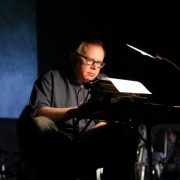Finding the Emotion in “Left-Brain Music”: A Response to Robert Baksa (Part 2)
When I hear any music in an unfamiliar style for the first time I’m often (maybe always) unable to judge or understand it deeply, and I’m certainly not able to respond with any deep feeling to it. Never mind whether the music has triads in it or not. For example: the first time I heard Monteverdi (it was Wendy Carlos’s realization of excerpts from L’Orfeo) I was baffled—I thought it was awful and boring. But once I got used to how it went, I found that I could respond intellectually and emotionally.
I’ll be the first to admit that a lot of our twentieth-century music has a much sharper learning curve. But I learn, with time. After many listenings, I find Schoenberg’s Variations for Orchestra beautiful; the variety of melodies and rhythm, and above all the sense of timing move me just as I’m moved when I hear Brahms’s Haydn Variations. And I’m excited and thrilled by the psychological drama Elliott Carter creates in his second string quartet. After spending some time listening with the score in hand, I find I can hear the dialogue Carter tries so hard to create in the music and perceive the very different personalities of the four instruments. And all this is in addition to what I intellectually understand about the compositional techniques in the music.
And surely some popular twentieth-century music can be very dissonant indeed. Think of Stravinsky’s Rite of Spring, which speaks clearly and easily even to the most uninitiated audiences. Now for me, the Rite is one of the most overrated pieces of our time. Still, I can’t deny the emotional power it has over me and over its audiences. There’s a lesson to be learned here. What if I had convinced people to believe, as I do, that The Rite of Spring should be retired from the repertoire? I wouldn’t have all the wonderful music written by men and women who have been inspired by it. And I have no doubt that it will inspire others to compose other music that I might love in the future. So will I discourage people from loving it, from learning more about it, from listening to it? No, of course not. I believe that we have no way of knowing what positive effects music can have, so why not allow it in? Why lock the door? This is, rightly or wrongly, what I think Mr. Baksa asks us to do—and all because he can’t respond emotionally to some twentieth-century and contemporary music and can’t accept the possibility that some of us do.
As a Cage enthusiast I couldn’t help but be irritated by Mr. Baksa’s facile and completely ad hoc dismissal of his music. Already I think there’s a wide appeal for some of Cage’s early work; the Sonatas and Interludes for Prepared Piano has been recorded over a dozen times and many people think it is a masterpiece, for instance. And now that we have a wide variety of Cage’s music available in wonderful recordings (the ones on Mode are the best for my money), I imagine other pieces will begin to make their mark, too. I will suggest two that I loved on the very first hearing: First, Roaratorio, that ebullient and richly textured glossing of James Joyce’s Finnegans Wake on Mode 28–29 and Wergo 6303 (American Record Guide, Nov/Dec 1994). The world of sounds and music that Cage assembles evokes so many emotions in me, from a concert-hall reverence (the operatic aria) to wonder and joy. And of course Cage’s voice, reading his unfathomable mesostics on Joyce’s name, always moves and reassures me. A second work, of a much different sensibility, is Fourteen, a kind of concerto for bowed grand piano and thirteen instruments on Mode 57 (ARG, May/June 1998). The bowed piano has a stunning, gorgeous, lyrical sound; the other instruments, playing so simply and so unobtrusively, make me tranquil and attentive. In that piece I experience time in a way I never have before, and I’m certain others can respond positively if the music is here for them to experience.
In 1967, the great American scholar Leonard B. Meyer (in Music, the Arts, and Ideas) predicted a pluralistic musical culture in which diametrically opposing musical styles would co-exist: he advised listeners to stop attempting to judge which style was better and, instead, judge each according to its own standards of excellence and elegance. Now, more than ever, we must heed Meyers’s advice. We must build bridges to other styles, other generations—let alone other cultures. For if we continue to fight over who is right and who is wrong, what is emotional and what is intellectual, what we should cherish and what we should discard, we may find ourselves with no classical music at all.


Leave a Reply
Want to join the discussion?Feel free to contribute!